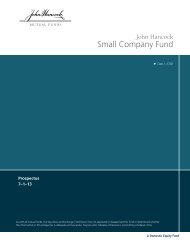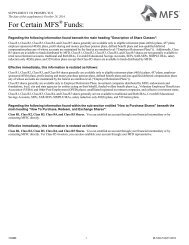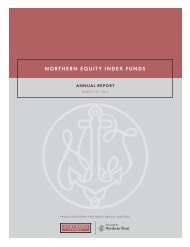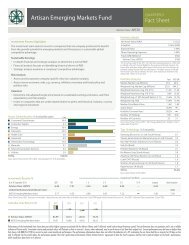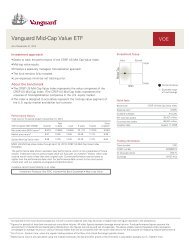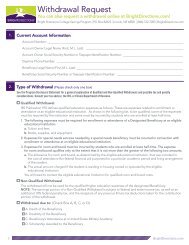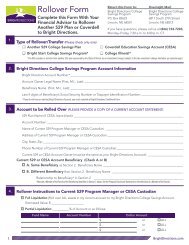Dodge & Cox Funds Statutoary Prospectus dated May 1, 2013
Dodge & Cox Funds Statutoary Prospectus dated May 1, 2013
Dodge & Cox Funds Statutoary Prospectus dated May 1, 2013
Create successful ePaper yourself
Turn your PDF publications into a flip-book with our unique Google optimized e-Paper software.
securities with different maturities. In addition, the Fundmay invest in credit default swaps to increase or decreasecredit exposure to a particular issuer or a group of issuersthat comprise a particular segment of the debt market.The proportions held in various debt securities will berevised in light of <strong>Dodge</strong> & <strong>Cox</strong>’s appraisal of theeconomy, the relative yields of securities in the variousmarket sectors, the investment prospects for issuers, andother factors. In selecting securities, <strong>Dodge</strong> & <strong>Cox</strong>considers many factors, including yield-to-maturity,quality, liquidity, call risk, current yield, and capitalappreciation potential.PRINCIPAL RISKS OF INVESTINGYou could lose money by investing in the Fund, and theFund could underperform other investments. Youshould expect the Fund’s share price and total return tofluctuate. The Fund’s performance could be hurt by:▪ Issuer risk. Securities held by the Fund may decline invalue because of changes in the financial condition of,or other events affecting, the issuers of these securities.▪ Management risk. <strong>Dodge</strong> & <strong>Cox</strong>’s opinion about theintrinsic worth or creditworthiness of a company or securitymay be incorrect, <strong>Dodge</strong> & <strong>Cox</strong> may not make timelypurchases or sales of securities for the Fund, the Fund’sinvestment objectives may not be achieved, and the marketmay continue to undervalue the Fund’s securities.▪ Interest rate risk. Debt security prices may decline due torising interest rates. Debt securities with longermaturities are generally subject to potentially greaterprice volatility than obligations with shorter maturities.A low interest rate environment creates an elevatedrisk of future price declines, particularly for securitieswith longer maturities.▪ Credit risk. A security’s price may decline due todeterioration in the issuer’s or a guarantor’s financialcondition. The Fund could lose money if the issuer orguarantor of a debt security, or the counterparty to aderivative instrument or other transaction is unable orunwilling to make timely principal and/or interestpayments, or to otherwise honor its obligations. If anissuer defaults, or if the credit quality of an investmentdeteriorates or is perceived to deteriorate, the value ofthe investment could decline.▪ Below investment grade securities risk. Debt securitiesrated below investment grade, also known as “highyield”or “junk” securities, have speculativecharacteristics. These securities may yield a higher levelof current income than higher-rated securities, butgenerally have greater credit risk, more price volatility,and less liquidity.▪ Call risk. During periods of falling interest rates, issuersof callable bonds may repay securities with higherinterest rates before maturity. This could cause theFund to lose potential price appreciation and reinvestthe proceeds at lower interest rates.▪ Derivatives risk. The Fund’s use of interest rate and creditderivatives involves risks different from, and possiblygreater than, the risks associated with investing directly insecurities and other more traditional investments. Thesederivatives are subject to potential changes in value inresponse to interest rate changes, or other marketdevelopments, or the risk that a derivative transactionmay not have the effect <strong>Dodge</strong> & <strong>Cox</strong> anticipated. Creditdefault swaps are subject to credit risk relating to theissuer or issuers of the reference obligations. Derivativesalso involve the risk of mispricing or improper valuationand poor correlation between changes in the value of aderivative and the underlying asset. Derivativetransactions may be highly volatile, and can createinvestment leverage, which could cause the Fund to losemore than the amount of assets initially contributed tothe transaction, if any. There is also the risk that the Fundmay be unable to close out a derivative position at anadvantageous time or price, or that a counterparty may beunable or unwilling to honor its contractual obligations,especially during times of financial market distress.▪ Liquidity risk. The Fund may not be able to purchase orsell a security in a timely manner or at desired prices orachieve its desired weighting in a security.▪ Mortgage and asset-backed securities risk. Early repaymentof principal (e.g., prepayment of principal due to sale ofthe underlying property, refinancing, or foreclosure) ofmortgage-related securities (or other callable securities)exposes the Fund to a potential loss on any premium toface value paid and to a lower rate of return uponreinvestment of principal. During periods of risinginterest rates, prepayment rates may decline below whatPAGE 18 ▪ D ODGE & C OX F UNDS




